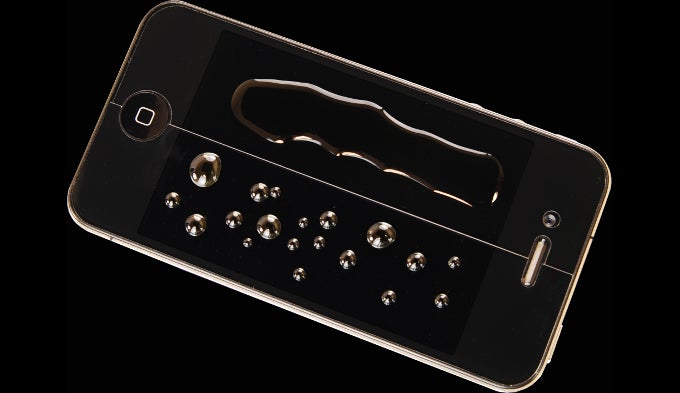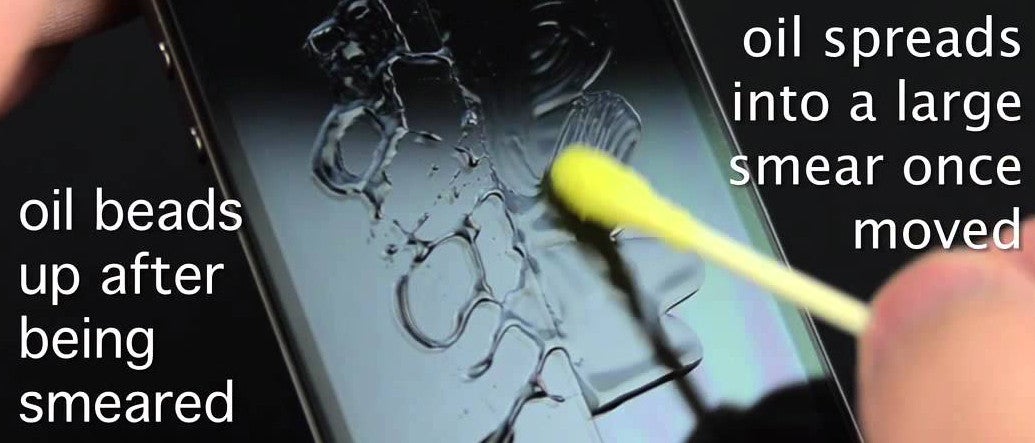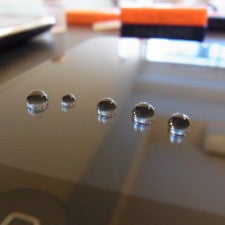Oleophobic coating – what it is, how to clean your phone, what to do if the coating wears off

Image courtesy of Green Onions Supply
By this day, you've probably seen the term "oleophobic coating" on some tech-selling sites – it's sometimes mentioned in phone specs, while at other times screen protector manufacturers will boast about it on their product's page. But what exactly is this strangely-named substance, what does it do, and is it really important?
Well, it is. In reality, all modern smartphones have a thin glaze of the material covering their screens, which is probably why you don't see it toted so often on product pages, unless the manufacturer is really reaching for positive features to list. See, "oleophobic" is a word used to describe a type of material, which lacks an affinity to oils, ergo – it keeps fingerprint spots off of a glass panel. The idea to use such a coating entered the world of mobile phones with the iPhone 3GS, which was the first handset to be covered with this type of solution.
Oleo-what now?
Oleophobic coating provides a certain amount of finger smudge resistance to your smartphone's display; it doesn't make it fingerprint proof, mind you, but keeps the grease at bay, not allowing it to adhere to the glass. This is why a simple wipe with a soft cloth will often leave the smartphone looking brand new, without the use of any extra cleaning solutions. Usually, if any normal glass has fingerprints on it, trying to wipe it with nothing but a cloth will bring much different results – the grease spreads across the surface and just follows the cloth's strokes, without coming off completely – it generally needs some kind of cleaning solution to be completely cleaned off.
The oleophobic layer also has a slightly slippery feel to it, which makes our gadgets feel slick to the touch. This also helps the glass be more scratch resistant, as a reduced friction will cause dangerous materials to slide off the surface, rather than damaging it. Ever wondered why brand new smartphone screens feel a bit more slippery (in the good way), compared to the one your 1- or 2-year old handset? Well, the fresh layer of oleophobic coating is the answer. It, unfortunately, wears off with time. How long it would take for your specific screen to shed off its grease protection could be highly individual. First, it depends on amount and type of usage; second, each human's body has varying levels of acidity to their sweat, and third, the method of bonding the coating to the glass, and the type of polymer used, is entirely up to every single manufacturer, and thus – we have coatings of different qualities that can last for various time periods, and may feel slightly different to the touch (though, the quality issue is mostly normalized, as most manufacturers use Gorilla Glass, which comes with its own coat). Generally, an oleophobic coat should be able to last a smartphone's typical 2-year life cycle, however, misuse, poor quality, or just bad conditions could cause it to wear out within months.

Image courtesy of Green Onions Supply
How do I clean my smartphone's screen and should I mind its oleophobic layer?
Yes, you should. It is not recommended to use any alcohol-based solutions when cleaning a capacitive touchscreen, neither is it a good idea to apply common household detergents, even if it's stated that they can be used for computer and / or TV screens. The aggressive compounds in such cleaners can easily wipe off the oleophobic coat and leave your glass “naked”.
Cleaning your mobile device's glass should generally be done with just a soft, cotton rag. In extreme cases, water-based solvents should do the trick – cleaners that are specifically designed for touchscreens can be bought at various outlets, just make sure to check the ingredients, as many manufacturers will feel no remorse in stamping an alcohol-based detergent as mobile-friendly. Also, applying the detergent to the rag, rather than spraying it directly on the screen, is a good idea.
I think my oleophobic layer has worn off, what should I do?

Water drops on oleophobic coating. Image courtesy of iFixit

If you absolutely refuse adding a third party film between you and your smartphone, you can buy an oleophobic coating kit. It consists of a tube of the grease-repelling polymer and a soft rag, which is used to distribute the chemical evenly across the screen – not a hard thing to do at home. Be advised, however, that such an aftermarket appliance will not be the same as the factory-baked layer and will most probably last less than your original coating did. Still, if you've done it once, you can do it again in a few months, no biggie. Plus – some users report that after application, the material actually covers up some of those annoying, shallow, visible-only-under-certain-lighting scratches.
image sources: iFixit, Green Onions Supply










Things that are NOT allowed: